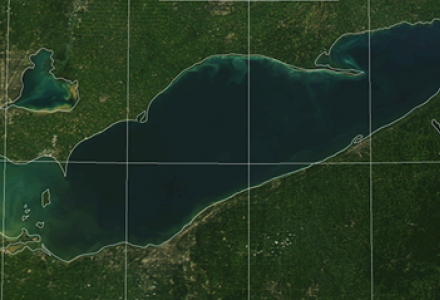
The regulatory board that helps manage Lake Ontario and St. Lawrence River outflows has a new decision support tool equipped with a database, impact assessment calculations and an interface featuring charts, graphs and multi-colored maps.
For the International Lake Ontario-St. Lawrence River Board, this interactive computer-based tool will be a powerful resource.
“The decision support tool will further support the board in assessing impacts associated with high water levels throughout the lake and river system. It is important to remember Lake Ontario remains a natural system,” said Steve Durrett, US co-chair of the board.
The six-member board is using the decision support tool to help monitor operations related to Plan 2014, which was put into use in 2017. The plan sets the rate of outflow from Lake Ontario into the St. Lawrence River through the Moses-Saunders Power Dam and, in so doing, has some effect on the water levels on the lake and river.

A screenshot of the decision support tool. Credit: Great Lakes-St. Lawrence River Adaptive Management Committee
When levels reach extreme high or low points, the board has the authority to step in and institute outflow changes, known as deviations.
“The decision support tool reminds us that the water levels of the Great Lakes cannot be fully controlled through adjustment of outflows, nor can outflow adjustments eliminate the risk of extreme water levels occurring during periods of very wet and/or very dry water supply conditions,” said David Harper, Canadian co-chair of the board.
In the wake of record-setting high water events on Lake Ontario and the St. Lawrence River in 2017 and 2019, board members sought additional information to inform future outflow strategies that can help balance impacts to various regions of the lake or river. The board does not want to cause unforeseen harm to interests or regions with such outflow deviation decisions.
Board members also have been challenged by a lack of reliable long-term forecasts of the Lake Ontario water supply, which means there is considerable uncertainty in whether the benefits of an outflow strategy could be undercut by weather-driven changes in water levels. Improved assessments of the probabilities of occurrences could help the board to better assess risk.
The IJC decided that Phase 1 of the review should focus on providing the board with as much information as possible to aid in making outflow decisions in response to any near-term recurrence of extreme high water events. The Great Lakes-St. Lawrence River Adaptive Management (GLAM) Committee conducted the recently-completed Phase 1 of the review and is now beginning Phase 2.
The decision support tool is one significant result of the Phase 1 review effort. It draws on research and information collected by the GLAM Committee and many partners and agencies to catalog the impacts of the 2017 and 2019 high-water events on uses and interests throughout the system. Researchers also determined the water levels at which those impacts occurred.
This data formed the basis of the tool, which projects the likely real-world impacts of high water over the coming six months on shoreline properties, commercial shipping, recreational boating, municipal infrastructure and other interests. It then shows how a given deviation strategy may change those impacts for better or for worse.
The tool allows the board to compare a deviation’s impact on different interests. For instance, the tool shows the number of waterfront homes that could be hit by flood waters on the lakeshore versus the riverbank if a given deviation was implemented.
The tool gives the board up-close views of potential impacts at select waterfront communities on the river and lake as well as on a section of the river known as Lake St. Lawrence where water levels are acutely affected by outflow changes. Researchers created features dubbed “impact zones” to allow comparison of the effects of extreme high water at each of the locations.
In addition, the tool addresses the uncertainty of future water supplies by showing the board how outcomes of a given outflow strategy would change under various possible water supply scenarios.
In all, the decision support tool provides the board with detailed data presented in a systematic way that allows members to better judge the scope of potential impacts from the deviation choices they’re considering.
The decision support tool should be considered a dynamic application. The tool is only effective if the board has full confidence in the information it provides. It is therefore critically important for the tool to be continually updated and improved over time as an ongoing component of adaptive management. The development of this tool will continue in Phase 2 of the Expedited Review of Plan 2014.
The GLAM Committee's Phase 1 report on the Expedited Review of Plan 2014 will be published in the coming weeks.

Steve Orr is a science writer in Rochester, New York, who has been assisting the Great Lakes-St. Lawrence River Adaptive Management Committee with the Plan 2014 expedited review.



